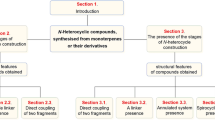Summary
-
1.
The reaction of the bromohydrin acetate (I) with carbazic ester goes stereospecifically, like its acetolysis, and leads to the cis acetate hydrazone (III) with inversion of configuration.
-
2.
About 30% of the products of the analogous reaction of the bromohydrin (II) have the configuration of the starting compound. It is considered that these products arise as a result of the reaction of the bromohydrin (II) in the diequatorial conformation, whereas under these conditions the diaxial conformer gives products of inverted configuration.
-
3.
The isolation of the monoacetates (III), (V), (VII), and (IX) from the reaction products indicates the high stability of the secondary acetoxy group, as compared with the tertiary, and therefore the occurrence of acyl migration in the 1-acetyl-1,2-cyclohexanediol series.
-
4.
The probable mechanism of the transformations observed is discussed.
Similar content being viewed by others
Literature cited
A. A. Akhrem and A. M. Moiseenkov, Izv. AN SSSR. Ser. khim.1966, 2156.
A. M. Moiseenkov and A. A. Akhrem, Izv. AN SSSR. Otd. khim. n 1963, 1064, 1446.
T. I. Temnikova, Course on the Theoretical Principles of Organic Chemistry [in Russian], Goskhimizdat, Leningrad (1962), p. 433.
C. K. Ingold, Structure and Mechanism in Organic Chemistry [Russian translation], IL, Moscow (1959), p. 251.
C. L. Stevens, P. Blumbergs, and M. Munk, J. Organ. Chem.,28, 331 (1963).
A. E. Favorskii, J. Prakt. Chem.,88, 641 (1913); S. Danilov and E. Venus-Danilova, Ber.62, 2653 (1929); T. I. Temnikova and E. N. Kropacheva, Zh. obshch. khimii19, 1917 (1949); C. L. Stevens, W. Malik, and R. Pratt, J. Amer. Chem. Soc.72, 4758 (1950); C. L. Stevens and E. Farkas, J. Amer. Chem. Soc.74, 618 5352 (1952); A. Kirrmann, Bull. Soc. chim. France 657 (1961).
R. Justoni and M. Terruzzi, Gazz. chim. ital.78, 155 166 (1948); R. Deghenghi and R. Grandy, Can. J. Chem.39, 1553 (1961).
C. Djerassi, J. Amer. Chem. Soc.,71, 1004 (1949).
V. R. Mattox and E. C. Kendall, J. Biol. Chem.185, 601 (1950); W. F. McGuckin and E. C. Kendall, J. Amer. Chem. Soc.74, 5811 (1952); F. Ramirez and A. F. Kirby, J. Amer. Chem. Soc.75, 6026 (1953).
Author information
Authors and Affiliations
Additional information
Translated from Izvestiya Akademii Nauk SSSR, Seriya Khimicheskaya, No. 12, pp. 2161–2167, December, 1966.
Rights and permissions
About this article
Cite this article
Akhrem, A.A., Moiseenkov, A.M. Corticosteroid analogs Communication 15. Reactions of 1-acetyl-1-bromo-2-cyclohexanol and its acetate with carbazic ester. Russ Chem Bull 15, 2092–2096 (1966). https://doi.org/10.1007/BF00867706
Received:
Issue Date:
DOI: https://doi.org/10.1007/BF00867706




